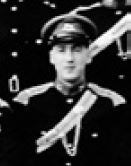Peter Clarke, who was born in 1927, spend most of his early years on Vancouver Island, Canada. However, shortly before the outbreak of war, the family returned to the UK in order that his father, who had been a fighter ace in the First World War, could take over management of a firm manufacturing aircraft.

During an air raid on Hampshire their house was damaged and the family, with the exception of Peter, returned to Canada.
He was educated at Eton and spent two years in the eleven as a highly successful wicketkeeper-batsman.
Joining the Army in 1946, although he had intended to take a regular commission, he also hoped that he would pass through the RAC OCTU, thus enabling him to join The 3rd Hussars who were then serving in Palestine.
Much to Peter’s regret and disappointment, the regimental hierarchy had other ideas and decided that coming from a regimental family, he should join the newly re-opened RMA Sandhurst with Intake 1. It was therefore not until the autumn of 1948 that Peter joined the Regiment in Lubeck.
Peter was a dedicated regimental officer, committed to his chosen profession, but still able to find time to enjoy skiing, shooting, fishing and polo. He attended the Gunnery Instructors’ Course at Lulworth and his success there led to his speedy return to the Gunnery School as an instructor.
When in 1957 the Regiment was informed that it was to be amalgamated with The 7th Hussars the following year, a considerable amount of the administration involved in the relocation of the Regiment from Germany to the UK fell to Peter as the last adjutant Peter then joined his new Regiment, The 14th/20th Hussars, and in 1959 attended the Staff College.
Following Command of a Squadron in The 14th/20th, Peter was seconded as an equerry to the Household of Her Royal Highness Princess Marina, Duchess of Kent. He returned to The 14th/20th for one final tour at Regimental duty before returning to Princess Marina’s Household as her Comptroller and providing a similar service for Princess Alexandra.
At the time of Princess Marina’s death, Peter Clarke shouldered much of the burden of the administrative tasks surrounding her funeral. Shortly afterwards, Peter was sent for by The Queen and created a CVO for all he had done for Princess Marina, especially at the time of her death.
Although continuing as a member of Princess Alexandra’s household, Peter joined the office of the Duchy of Lancaster as Chief Clerk. Peter’s duties included liasing with Lords Lieutenant and their appointments to advisory committees on the selection of magistrates within the Duchy and their administration. He was also closely involved in the appointment of clergy to the 42 Duchy Livings.
In all these tasks, Peter was meticulous in his attention to detail and tireless in his efforts to secure an appointment which would be right for the individual as well as the post to which he was appointed.
On his retirement from the Duchy, The Queen invested him with the KVCO in recognition of his long service to the Royal Family.
Throughout his working life, Peter’s path crossed that of Peter Cavendish. They first met when he was a cadet at Sandhurst and Cavendish was the General’s ADC. They were 3rd Hussars together and sometime after he transferred to The 14th/20th, Peter Cavendish took command of that Regiment.
However, probably their closest working relationship was when Peter Cavendish was appointed Colonel of The 14th/20 whilst serving at NATO Headquarters in Brussels.
In this role, he needed somebody to deputise for him, particularly in regard to the recruitment and interviewing of potential officers, and not surprisingly, Peter Clarke was his choice, a task which he found time consuming but very enjoyable and which continued for 5 years.


